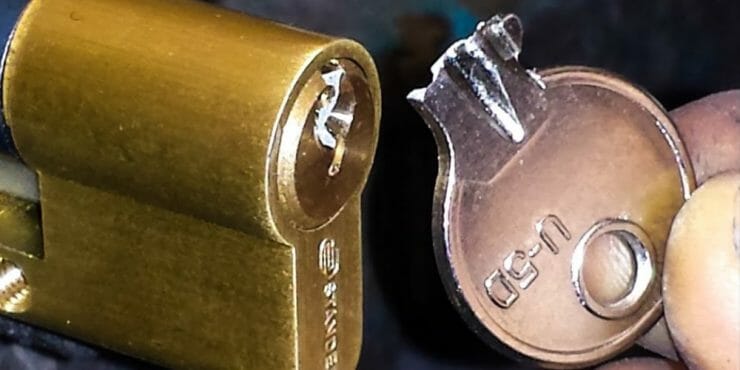As a security installer/ locksmith one of my most common calls is a broken key stuck in a lock. Often, a key stuck in a lock seems like an emergency, and your priority will be to contact a locksmith to remove it.
Based on the depth of the key, you can open the lock with the help of pliers, metal pieces, and other tools.
I will cover all these methods and more you can use in my guide below.
Why do Keys Break in locks?
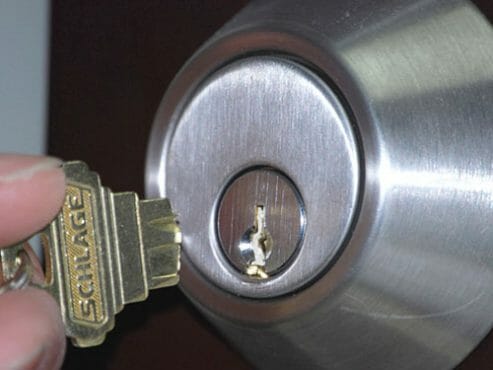
While keys breaking inside the lock can be annoying, you’d be surprised to know just how common it is.
One of the most common reasons this could happen is when the key is made of soft metals, such as nickel and brass. The relative softness can cause it to break when used.
In addition to this, using old keys could also be a catalyst. Another reason could be that the lock-in is insufficiently lubricated.
To prevent the key from breaking within the lock, maintaining both the key and the lock is vital, as both the metal substances are prone to wear, tear, rusting, and corroding. (1)
What To Do When A Key Breaks In The Lock
We’d suggest you take precautions next time, but let’s focus on understanding what steps you can take after a key breaks in the lock. Time is of the essence. The longer the key remains within the lock, the more damage it can cause since rain and corrosive elements can be rusted in with the key.
Moreover, if you don’t remove the key in time, you could be exposing your home to the risk that the door may stay open or face the threat of having the door remain perpetually locked until the issue is resolved. The problem needs to be dealt with as soon as it occurs to prevent further damage.
Before we dive into the methods of removing the key, let’s briefly touch upon some prepping points and the items you’d need to remove the key.
Preparation
Before removing the key from the lock, you’d have to prepare quickly to get the job done without a hitch.
Lubricating the lock and key
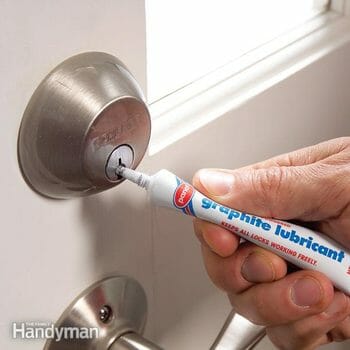
Lubricating the key housing insides can help remove the key easily.
The prime thing to consider here is using the right lubricant. Ideally, a lubricant with graphite or other kinds of dry lubricant should be preferred to loosen the grip of the key inside the lock.
If you’ve locked yourself out of the house, you can borrow your neighbor’s toolbox. A lot of people prefer something like oil-based lubricants such as WD-40 spray. Although, there are some drawbacks to using this kind of lubricant, one of them being that it can stain the metal. Keep a towel or a piece of paper close at hand to wipe off any excess lubricant that slips out of the keyhole while spraying. Adjust the nozzle so it aims straight inside the key lock.
You are golden if you can also get your hands on a pair of needle-nose pliers, as it can help speed things up. You can pluck the broken piece right out when it’s within range.
Things You’d Need to Remove The Lock
Make sure you gather the things you’d need to safely remove a broken key from the lock before getting to work.
Here is the breakdown of the inventory you’d need for all the ways mentioned in the article to work.
- Tweezers
- Broken Key extractor
- Emergency Toolbox
- Needle-nose Pliers or a magnet
- Super Glue
- A Blade
Make sure that you don’t push the key in too much. If it doesn’t get out by prodding a little, use one of the 6 ways that we’ll be discussing, as pushing the key too much would do more harm than you are good.
You could run the risk of pushing the broken key deeper into the lock, making it harder to get it out. Give it a good wriggle once, if nothing happens, follow one of the ways mentioned below.
Quick Summary
Here are seven different effective methods how to get a snapped key out of a lock.
- Using a Pair of Tweezers
- Using a Broken Key Extractor
- Using a Hacksaw Blade
- Using Super Glue
- Probe and Pull the key out
- Using A Paper Clip
- Using a Driller
1) Using A Pair of Tweezers:
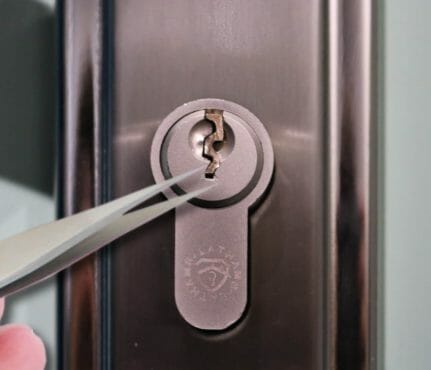
Tweezers are one of the most common household materials that can be used to remove a broken key from a lock. It’s easy to get your hands on a pair of tweezers from your neighbors if your house key broke inside the lock.
Although certain factors would limit the effectiveness of tweezers in getting the broken key out, one of them is the thickness of the tweezers.
Make sure that the tweezers are appropriate in size, and thickness, thin enough to be inserted into the inner walls of the keyhole, but not thick enough to push the broken piece of key even farther while trying to remove the key.
This can make finding the perfect set of tweezers a bit tricky. Although, if a fragment of the key is visibly protruding from the keyhole, average size tweezers could come in handy, as you could pinch the broken fragment with the tweezers, and pull it out with a sudden jerk. This little trick can be pulled off by anyone.
However, if there is no visible piece of broken key protruding from the keyhole, do not attempt this method. You’d end up pushing the piece even further into the lock, making it twice as difficult, or even impossible to remove the broken key.
2) Using a Broken Key Extractor:
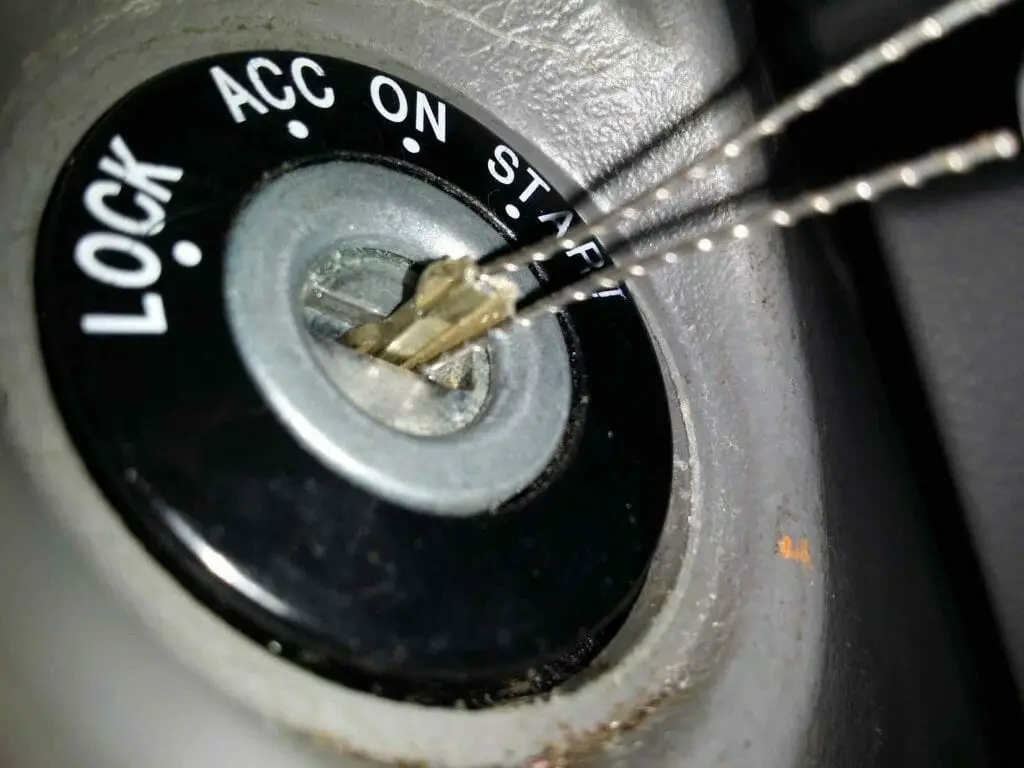
This method is a little more difficult, as you’d be required to have a tool called a broken key extractor to carry it out.
You could drive to your local hardware store and purchase this instrument. The broken key extractor comes with a thin rod of metal, with a hook on the end to loop in the keyhole.
It is this rod that you’ll be sliding inside the keyhole. Make sure to buy the extractor that’s suitable for the kind of lock you have. To remove the broken key using this equipment, insert the extractor in such a way that the hook faces upwards. Then, twist around the lock to hook the broken key into the extractor.
Once the extractor is hooked to the bottom of the key piece, gently try to slide it out along with the key fragment. There is no need to pull the entire chunk out, a small part of it would do. From there, you can use tweezers to yank the broken key out.
While a key extractor would 100% work in pulling the broken key out of the lock, it is unlikely that you’d have such a professional tool close at hand, unless you buy it from a hardware store, as mentioned before. However, if all else fails, you can make a DIY key extractor.
3) Using A Hacksaw Blade:
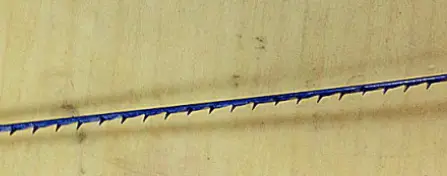
Wondering how to get a snapped key out of a lock without a broken key extractor? A hacksaw blade can be a good last solution. You can make a DIY blade if you don’t have a key extractor.
A few household tools would be needed for making this, and you can easily get them all from a neighbor or your local hardware store.
For this, you will need a thin blade from a hacksaw. Try to find the smallest one possible, as you would be sliding the piece within the keyway, which will be incredibly small. If you don’t have.
Ideally, the rod should have a serration with an angle on the end. This will serve as the hook that fastens the broken key. You can angle the serration towards you to grip the fragment. If the angling is done well, and the rod is thin enough, you can easily slide in the blade, hook the broken key onto the angled serration, and haul the key out without a hitch, which will be enough for it to then be pulled out using a pair of tweezers. Just insert the hacksaw blade, turn and twist a little to find the edge of the broken key, and gently try to pull it out.
Try again if the first attempts fail, but make sure that the broken key is not pushed further into the lock. The least these tries would do is gradually draw the key out. Do not force the key to be pulled out. If you fail to hook the key onto the blade in the first few attempts, make some tweaks on the teeth of the blade or the rod, to make the process smoother. Patience is important for this method to work.
4) Using Super Glue:
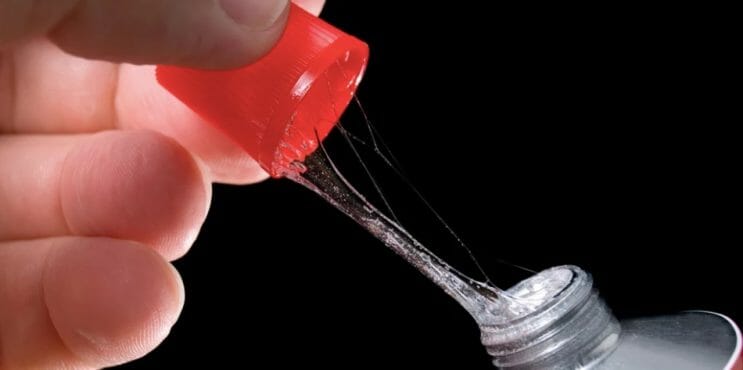
If you don’t have the tools to perform the above-mentioned methods, we can always be a little old school and use super glue to do the trick.
The thing to keep in mind before using this method is that the success rate isn’t as solid as using the key extractor or hacksaw blade. The chances that it will work are slim but present nonetheless. So, it’s certainly worth a shot if you have absolutely no resources to work with such as a blade, toolbox, or a key extractor. Just make sure that at least some part of the broken key is visible through the keyhole. If it has been pushed all the way back, and no metal is visible, then this trick won’t work at all.
For this method, all you need is super glue and a match. Ordinary glue won’t work as you’d be required to pull the broken key out using just the glue.
Apply some super glue on one end of a match. You could also use a thin metal wire for this. Ensure that you don’t overapply glue, as that could prove to be counterproductive. Likewise, underapplying would also pose a problem, as the key won’t stick.
Insert the match or wire inside the keyhole and gently touch the broken piece.
Without pushing it farther, establish contact with the key and wait for a few seconds for it to bind. Then, gently slip the key piece out.
Once the fragment protrudes from the keyhole, use pliers or tweezers to pull it out and remove the broken key.
5) Probe And Pull The Key Out:
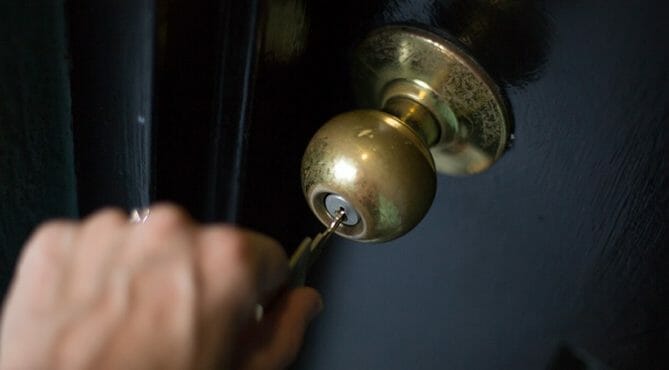
A more primitive style of removing the broken fragment of the key from the lock is using two thin pieces of metal and probing and pulling the key out.
If you don’t have metal pieces close at hand, you can also consider using thin plastic pieces, or if possible cutting two thin strips of paper from playing cards, those would do the trick too.
Slide the two pieces on either side of the key which is wedged between the inner walls of the lock.
Don’t push it too far, just enough that the pressure is applied firmly, and pulling the key out becomes easy.
If pulling the whole thing out appears to be tricky, repeat the process a few times to gradually draw it towards you, and then pull it out with a jerk using tweezers or even the pieces of metals if possible.
6) Using A Paper Clip:
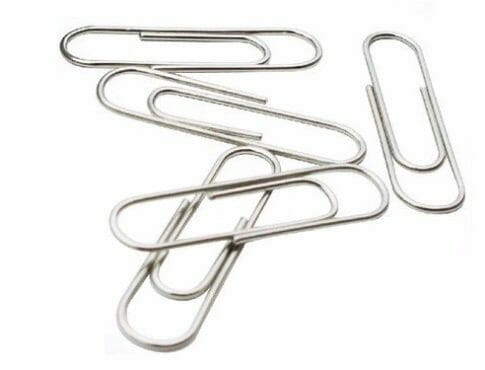
A paper clip is also an effective tool to remove the broken key from your lock.
For this method to work, you’d require a paper clip or perhaps a pair of pliers.
Straighten the paper clip by bending it using your thumb. You can also use tiny pliers for this.
Now, put it on top of the broken key, a little higher than the key. Twist and turn the clip in a downward direction in the lock entry. Once it hits the bottom of the lock entry, it may curl around the key, and then you can try to remove the broken key.
7) Drill The Lock:
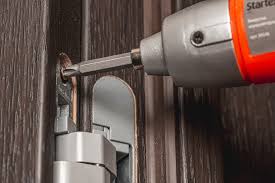
If none of the above-mentioned methods worked for you, you can also drill the lock if you don’t mind damaging the lock. This method can be used in an emergency.
For this, you’d need a drill. Simply plug the instrument into a power outlet, and start drilling through the keyhole.
Keep drilling until the lock is broken enough to throw out the trapped fragment of the key. Break the lock using the device to unlock the door.
However, if you don’t have a drill, and no other instruments that could be used to pull the broken key out, you can always contact a locksmith to get the job done. Locksmith professionals may charge you a substantial fee but if you’re in a hurry or if it’s an emergency, getting help could be your last solution.
8) Bonus Method: Using a Magnet
When nothing else is working, a magnet can be used to remove metal from any surface. It is a useful tool in many different situations and it is always on hand.
All metallic objects can be magnetized. When a magnet is brought closer to a metal object, it takes on the magnetic field and the object becomes attracted to it. (2)
You can purchase some earth magnets which are incredibly strong and will remove the key.
How To Prevent a Key Getting Broken In The Lock
You know what they say, an ounce of prevention is better than a pound of cure. Now that you’ve learned your lesson, you might prepare yourself for the future, and prevent this again.
Here are two methods you can use to prevent the key from ever getting broken and stuck in the lock.
1. Lubricate the locks regularly:
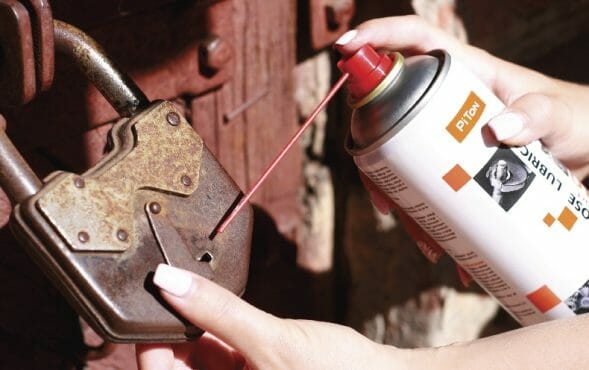
Locks are prone to wear and tear, and rusting due to the iron content present in some of them.
One of the ways to prevent the key from getting broken in a lock is to maintain it properly.
Lubricating the insides of the lock is a good way to start. Consider spraying a silicone-based lubricant into the lock after every six months or so.
If the lock starts misbehaving, and it becomes difficult to smoothly slip the key in and out of the lock, then you can spray some lubricant inside the keyway.
2. Replace Keys:
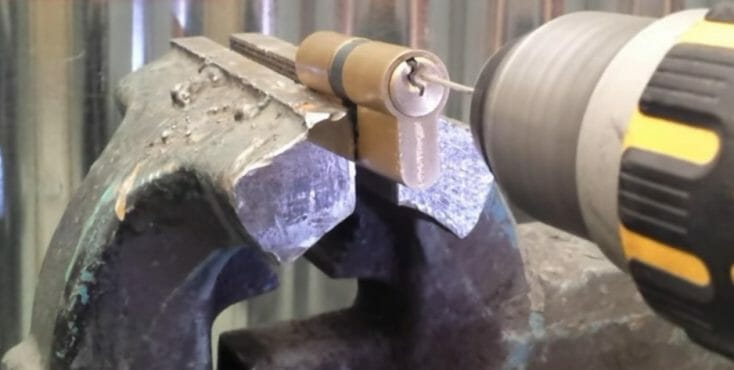
Just like locks, keys can also be subject to wear and tear after rigorous use. Apart from lubricating the lock regularly, you can also make duplicates of your key and keep replacing the main one if you believe it’s time for the existing one to be retired.
Minimizing the use of old keys would minimize the chances of the key getting broken inside the lock due to wear and tear.
Frequently Asked Questions About How To Remove a Broken Key From a Lock
What if the key is still stuck?
Although the seven ways mentioned above should remove the key, it’s possible that none of them would work, or maybe you have no tools at your disposal to carry out even one of the methods. If this happens and the lock won’t budge, you can contact a locksmith to fix it.
Can a locksmith help?
Yes, locksmith experts know how to remove a broken key from the lock. Locksmiths can use professional tools inside the lock to loosen the stuck key.
Locksmiths not only manually open locked doors and safes but also provide expert advice on security. They use a variety of tools and techniques to gain access, such as picking locks or drilling through walls.
Can I get a new key custom-made?
If you need a new key for your house or apartment, it may be more cost-effective to go through the landlord. If you need keys for several different locks in one place, try notifying your neighbors about possible cooperation in getting them made.
You can also get a new custom-made key from the locksmith.
How much does it cost to get a new key made?
The cost of a new key depends on the lock cylinder, so it’s hard to give an exact answer. However, the price range will be between $50 and $250, with most keys around $100.
The cost for changing locks is expensive but it’s important to have your locks changed if they are compromised.
References:
(1) metal substances – https://www.britannica.com/science/metal-chemistry
(2) magnetic field – https://www.khanacademy.org/science/physics/magnetic-forces-and-magnetic-fields/magnetic-field-current-carrying-wire/a/what-are-magnetic-fields

